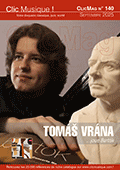 Ne confondez pas ! S’il s’agit bien ici du Bruckner des neuf Symphonies, le Wieniawski en question, Józef (1837-1912), n’est pas Henryk (1835-1880), mais son frère cadet, pianiste virtuose pour sa part et compositeur à l’occasion. Son unique Quatuor à cordes, date de 1880 et se recommande par l’alliance d’une architecture classique avec des harmonies et mélodies nettement « romantiques » si on songe à Mendelssohn ou Schumann. Le Quatuor en Ut mineur de Bruckner (1862), pour sa part, probablement parce qu’il était considéré comme un exercice de capacité du temps de la scolarité de Bruckner, faisant partie du Kitzler-Studienbuch, fut rédigé en 1862, et tomba dans l’oubli avant d’être redécouvert en 1950 par Rudolf Koeckert, fondateur du quatuor éponyme, et interprété pour la première fois à Berlin puis Hambourg en 1951. Son premier mouvement Allegro moderato est de forme sonate traditionnelle mais avec des modulations déjà audacieuses. L’Andante du second mouvement contraste à la manière de Beethoven. Le troisième mouvement s’inspire des Ländler autrichiens. Enfin le Rondo final Schnell, par ses contrastes mélodiques et agogiques, assure à l’œuvre une originalité particulière dans l’ensemble des quatuors du XIXe siècle. Le Glière String Quartet, rend toute justice à ces œuvres oubliées grâce à une cohésion sans faille et des alliances de timbres excellemment restituées par une prise de son de grande qualité. (Jacques-Philippe Saint-Gerand)  The album features two extremely interesting, rarely performed string quartets. Only in recent years has the output of the author of the former, Józef Wieniawski, become popular, thus coming out from the shadow of the achievements of the composer’s older brother, Henryk. The piece is of a Romantic, contrasting nature; it seduces us with a multitude of both lyrical and feisty motifs featuring Polish melodies, which are barely perceptible, but still present. Bruckner’s composition is a youthful work typical of late Austrian-German Romanticism, heralding the personal style of this great symphonist through, among others, a rich rhythmic and melodic texture and a dense polyphonic texture. It is worth paying attention to the sound of the Viennese ensemble composed of musicians coming from different countries, referring to the legacy of the golden era of string quartets from the last quarter of the 20th century. The ensemble’s interpretations are distinguished by a noble tone, Romantic phrases and technical virtuosity. The recording will charm every connoisseur of chamber music repertoire.
 |
